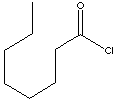PRODUCT IDENTIFICATION

H.S. CODE
TOXICITY
C(CCCCC)CC(=O)Cl
CLASSIFICATION
PHYSICAL AND CHEMICAL PROPERTIES
195 - 196 C
REFRACTIVE INDEX
82 C
EXTERNAL LINKS & GENERAL DESCRIPTION
USA.gov - Octanoyl chloride
Wikipedia Linking - Acid chloride
Google Scholar Search - Octanoyl chloride
PubChem Compound Summary - Octanoyl chloride
http://www.ncbi.nlm.nih.gov/ - Octanoyl chloride
Material Safety Data Sheet - Octanoyl chloride
EPA - Substance Registry Services - Octanoyl chloride
Local:
Acyl halide is one of a large group of organic substances containing the
halocarbonyl group, have the general formula R-CO.X (whrwe X is a halogen atom
and R may be aliphatic, alicyclic, or aromatic). Acyl is a radical formed from
an organic acid by removal of a hydroxyl group. the general formula is RCO,
where X is a halogen atom
(fluorine, chlorine, bromine, iodine, and astatine) and R may be aliphatic, alicyclic, aromatic,
and H etc. Acyl halides are made by replacing the -OH group in
carboxylic acids by a halogen using a halogenating agents. They react readily
with water, alcohols, and amines and are widely used in organic synthetic
process whereby the acyl group is incorporated into a molecule by substitution
called acylation reaction. In substitutive chemical nomenclature their names are formed by adding '-oyl' as
a suffix to the name of the parent compound; ethanoyl chloride, CH3COCl, is an
example. Capryloyl Chloride,
C8 acyl halide,
is a clear to yellow, corrosive liquid;
melting at -63 c; boiling at 196 C, refractive Index
of 1.435. It reacts with water;
soluble in ether,
acetone, and acetic acid. It is widely used
in the synthesis of fine chemicals,
agrochemicals (antifungal agent) and pharmaceuticals. The hydrogen atoms replace oxygen atoms in alcohols or
nitrogen atoms in amines, which protects amine groups during amino acid synthesis.
APPEARANCE
98.0% min
ACIDITY
1.0% max (Caprylic acid)